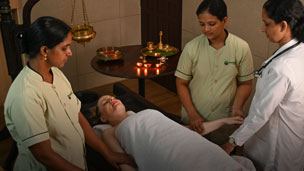







For authentic & scientific
ayurveda
Nagarjuna has developed speciality protocols
and adopted integrated and holistic approaches “to improve
the quality of life of ailing population”.
Inter Vertebral Disc Bulge
An intervertebral disc bulge, also known as a herniated disc, is a condition that can occur in any part of the spine, although it most commonly affects the lower back region. It is characterized by the protrusion or bulging of the intervertebral disc, which is the soft cushion-like structure located between the vertebrae that provides shock absorption and allows for flexibility in the spine. The terms herniated, bulging, protruding, or ruptured disc are often used interchangeably to describe this condition.
A herniated disc occurs when the outer layer of the disc, called the annulus fibrosus, weakens or tears, allowing the inner gel-like material, known as the nucleus pulposus, to push out or bulge beyond its normal boundaries. This can be caused by various factors, including age-related degeneration, repetitive stress, improper lifting techniques, trauma, or underlying conditions such as osteoarthritis.
When a herniated disc occurs in the lower back, it is one of the most common causes of lower back pain. The herniation of the disc can irritate or compress nearby spinal nerves, leading to symptoms such as localized or radiating pain, numbness, tingling, or weakness in the lower back, buttocks, thighs, or legs. This condition is often referred to as sciatica when the sciatic nerve, which runs from the lower back down through the legs, is affected.
The severity of symptoms associated with a herniated disc can vary depending on the extent of the disc bulge and the degree of nerve compression. In some cases, individuals may experience mild discomfort or intermittent pain, while in more severe cases, they may suffer from chronic pain and significant functional limitations.
The diagnosis of a herniated disc typically involves a comprehensive evaluation by a healthcare professional, which may include a physical examination, medical history review, and diagnostic tests such as imaging studies (e.g., MRI, CT scan) to visualize the spine and identify the presence and location of the disc bulge.
Treatment options for a herniated disc depend on the severity of symptoms and may include conservative measures, such as rest, pain medication, physical therapy, and specific exercises to improve core strength and flexibility. Heat or cold therapy, as well as the use of braces or supportive devices, may also be recommended to alleviate pain and provide stabilization to the affected area.
In cases where conservative treatments fail to provide relief, more invasive interventions may be considered. These can include epidural steroid injections to reduce inflammation and pain, or in rare cases, surgical procedures such as discectomy or microdiscectomy to remove the protruding portion of the disc and alleviate nerve compression.
It is important to note that the treatment approach for a herniated disc should be tailored to each individual's specific condition and guided by the advice of a healthcare professional. Early intervention, appropriate management, and lifestyle modifications can often lead to significant improvement in symptoms and the restoration of normal functioning.
In conclusion, an intervertebral disc bulge, commonly referred to as a herniated disc, is a condition that frequently affects the lower back and can cause significant pain and discomfort. It is a leading cause of lower back pain and can also result in leg pain or sciatica. Understanding the underlying causes, symptoms, and available treatment options can help individuals seek appropriate care and effectively manage this condition.
Please fill up the form to get in touch with us, or contact us for any queries





Terms of use | Privacy Policy | Contact us
Copyright © 2024. All Rights Reserved
Designed & Developed by Websoul Techserve








